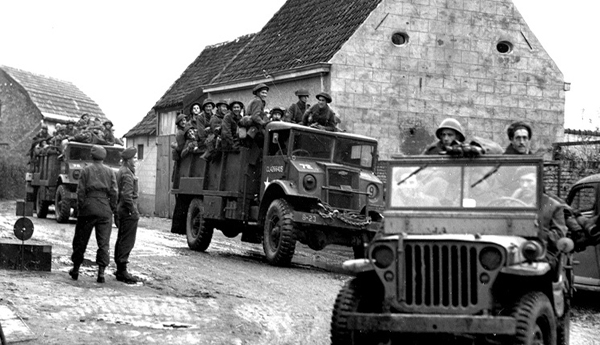The Latin American community has played a significant role in defending Canadian values and ethics throughout history. From Confederation onwards, individuals from Latin American countries, including Peru, actively participated in Canada’s military during times of conflict. This article highlights the remarkable contributions made by Peruvian soldiers who volunteered in the Canadian Armed Forces during the First and Second World Wars. Their dedication, bravery, and sacrifice exemplify the shared values between Latin America and Canada, serving as a testament to the strong and lasting bond between the two regions.
Trimer Vic Crothalin: Trimer Vic Crothalin was born in Peru and enlisted in the Canadian Mercantile Marine in the SS Halifax Wreck during the First World War. A cargo ship steam propulsion built in 1888. Having a missing cause lost on 11 December, 1917 with 37 casualties. Trimer Crothalin’s commitment to serving his newfound homeland is noteworthy. He joined countless other Peruvians who volunteered to defend Canada’s values, demonstrating the spirit of camaraderie and sacrifice. Trimer Vic Crothalin’s selflessness exemplifies the Latin American community’s dedication to upholding shared principles and the strength of the bond between Peru and Canada.
Sailor A. Velasquez: Sailor A. Velasquez was born in Peru in 1894 and died on 13 August, 1915 as a Canadian Mercantile Marine. Wreck HMS Royal Edward/Canadian Northern Steamships was an invaluable member of the Canadian Navy during the First World War. Velasquez’s service as a sailor exemplifies the dedication and courage of Latin American individuals who joined the Canadian Armed Forces. As a representative of Peru, Sailor A. Velasquez contributed to protecting Canadian values and promoting international peace. His commitment to the navy reflects the Latin American community’s deep-rooted respect for maritime traditions and the importance of collective defense.
Robert John Lancashire: Robert John Lancashire was born in Callao, Peru on 9 September, 1891 and died on 16 Jan, 1923 in the same city. Both of Lancashire’s parents came from Callao, Peru. His mother was Sofia Francisca Gillis (1868-1925) and his father Lewis Charles Lancashire (1853-1900). Before he joined Canadian Expeditionary Force, he was a Telegraph and Cable Operator enlisted in New York, USA on 9 Oct. 1918 serving the 2nd Depot Bn Eastern Ontario Regt (EOR) unit. Lancashire’s demobilization was in Ottawa on 26 Nov. 1918 and he made significant contributions as part of the Canadian Expeditionary Force during the First World War. His enlistment showcases the commitment of individuals from Latin American backgrounds to stand alongside Canadian Soldiers. Serving with honor and valor, Lancashire symbolizes the Peruvian soldiers who fought for freedom, justice and a brighter future for all (in this case from Canada due to the First World War ended on 11 Nov. 1918).
Captain Hedley Maurice Harrison: Born in South Africa, Capt Hedley Maurice Harrison died on 14 Aug. 1944 at the age of 30 years old. He was an exceptional leader in the Canadian Armed Forces during the Second World War, joining the Royal Canadian Artillery, 19 Field Regiment. Captain Hedley Maurice Harrison was a proud Canadian and son of Ernest Harrison and of Annie Gladys Harrison (nee Anyan), of Lima, Peru. Captain Harrison demonstrated his unwavering commitment to defending Canadian values and upholding global peace and is buried at Bretteville-Sur-Laize Canadian War Cemetery, France.
During the First World War, the Canadian and Allied merchant ships and mariners of the Merchant Navy played a crucial role in transporting personnel, munitions, weapons, and food to Great Britain and Europe. This massive undertaking involved navigating treacherous waters, evading German U-Boats and mines that claimed the lives of tens of thousands of Allied personnel and thousands of ships. Canada’s Grand Armada, in October 1914, saw over 31,000 troops transported on 31 ocean liners, escorted by Royal Navy warships as they sailed for England.
In the face of this daunting challenge, the Royal Canadian Navy and the Canadian Merchant Navy rose to the occasion. The Royal Canadian Navy, though relatively young and small at the outbreak of the war, expanded significantly by 1918 as their fleet grew to nearly 9,500 sailors and over 130 commissioned vessels, including numerous merchant marine vessels and sailors. However, the Canadian Merchant Navy faced a shortage of supply vessels, troop carriers and trained sailors. In response, thousands of Canadian merchant sailors, including some Peruvians, bravely left behind the comforts of home and familiar waters to serve their country and fight for freedom abroad.
Trimmers played a vital role in the Merchant Navy and these individuals ensured that coal was evenly distributed to maintain the ship’s trim and supplied the firemen with an adequate amount of coal for the boilers. They performed their duties using shovels, wheelbarrows and sheer physical strength, often working in cramped and challenging conditions. The engine room crews, including trimmers, regarded themselves as highly skilled professionals as their responsibilities were critical to the ship’s operation.
The perils faced by the Canadian Merchant Navy were magnified by the introduction of German U-Boats. These submarines silently lurked beneath the surface, posing a significant threat to the merchant ships. The Canadian Merchant Navy, responsible for transporting troops and essential supplies, became a lifeline for the troops fighting overseas. To mitigate the risk, the convoy system was implemented, grouping merchant ships together and providing them with warship escorts for protection. Trans-Atlantic convoys consisting of up to 60 ships traveled from Eastern Canada to European ports. These efforts were crucial in ensuring that vital resources reached the Allies, ultimately contributing to the Allied victory in late 1918.
The sacrifices made by Peruvians and other members of the Canadian Merchant Navy during the First World War should never be forgotten. Their dedication, bravery, and selflessness played an instrumental role in safeguarding Canadian and Allied interests. Memorials, such as the Tower Hill Memorial in London, United Kingdom, stand as a testament to the fallen Canadian seafarers, including Vic Crothalin and Sailor A. Velasquez, who lost their lives while serving their country.
By: Captain Rey Garcia-Salas Vasquez















